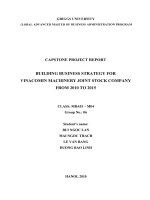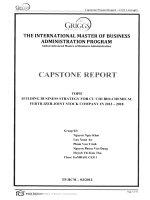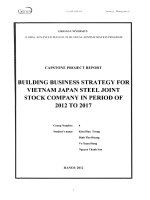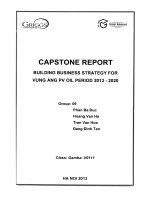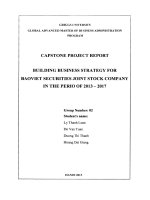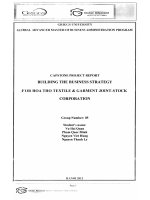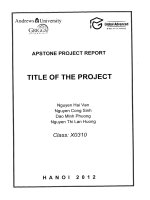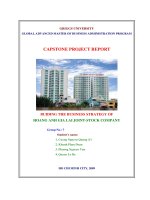Building business strategy for Viet Nam I industrial joint stock company in 2010-2015
Bạn đang xem bản rút gọn của tài liệu. Xem và tải ngay bản đầy đủ của tài liệu tại đây (1.03 MB, 70 trang )
GROUP 12 -GEMBA 01.V02
1
GLOBAL ADVANCED MASTER OF BUSINESS ADMINISTRATION
CAPSTON PROJECT REPORT
TOPIC: BUILDING BUSINESS STRATEGY FOR VIET NAM I
INDUSTRIAL JOINT STOCK COMPANY IN 2010-2015
Prepared by: Group 12
Class: GeMBA01.V02
No.
Full name
Note
1
Tran Thai Binh
Group leader
2
Tran Bau Ha
Group member
3
Pham Vu Long
Group member
4
Đao Xuan Tung
Group member
Ha Tinh, September, 3
rd
, 2010
GROUP 12 -GEMBA 01.V02
2
TABLE OF CONTENT
PREFACE
ABBREVIATION
PAGE
1. NECCESSITY OF THE STUDY
5
2. PURPOSE AND SCOPE OF THE STUDY
5
2.1. Study purpose
5
2.2. Study scope
6
3. STUDY METHODOLOGY
6
3.1. Methods to collect data
6
3.2. Data analysis
8
4. SIGNIFICANCES OF THE STUDY
8
CHAPTER I: THEORY BASIS OF BUSINESS STRATEGY
9
1. Definition of strategic management
9
1.1. Definition of strategic management
9
1.2. The role of strategic management
9
1.3. Classification of business strategy
9
1.4. Process of building business strategy
10
1.4.1. Strategic vision
10
1.4.2. Macro environment of enterprise
10
1.4.2.1. PEST model
10
1.4.2.2. Operational environment of enterprise
11
1.4.3. Internal environment analysis within the enterprise
12
1.4.4. Model of strategy choice
13
1.5. Basic competitive strategies
15
GROUP 12 -GEMBA 01.V02
3
CHAPTER II: REALITY OF CONSTRUCTION STONE TRADING
IN VIET NAM I INDUSTRIAL JOINT STOCK COMPANY
18
2.1. General introduction
18
2.2. Analysis of external environment.
20
2.2.1. PEST analysis
20
2.2.2. Five-force analysis
24
2.2.2.1. Customers
24
2.2.2.2. Current competitive opponents
25
2.2.2.3. Replaced products
27
2.2.2.4. Providers
2.2.2.5. Threats of new entrants
27
2.3. Analysis of internal environment
28
2.3.1. Administration
28
2.3.1.1. Definition
28
2.3.1.2. Organization
29
2.3.1.3. Leadership
31
2.3.1.4. Corporate Governance
32
2.3.2. Personnel
33
2.3.3. Marketing
33
2.3.3.1. Products
33
2.3.3.2. Price
34
2.3.3.3. Distribution
35
2.3.3.4. Advertisement
35
2.3.4. Production, quality management and equipment technology
36
2.3.4.1. Productional operation
36
2.3.4.2 Equipment and technology
38
2.3.5. Financial situation of company
39
2.3.6. Research and development
41
2.3.7. Information system
41
2.4. SWOT analysis for Vietnam I Industrial Joint Stock Company
41
GROUP 12 -GEMBA 01.V02
4
2.4.1. Main strengths
41
2.4.2. Main weaknesses
42
2.4.3. Main opportunities
42
2.4.4. Main threats
43
CHAPTER III: BUILDING BUSINESS STRATEGY FOR VIET NAM
I INDUSTRIAL JOINT STOCK COMPANY IN 2010 – 2015
45
3.1. Choice of business strategy
45
3.1.1. Application of QSPM model
45
3.1.2. Description of leading cost strategy
46
3.2. Business strategy building
46
3.2.1. Vision, mission and goals of the company
46
3.2.2 Functional strategies
47
3.2.2.1. SWOT matrix
48
3.2.2.2
Main strategy matrix
51
3.2.3. Strategy choice
52
3.2.3.1. Choose strategic solutions
52
3.2.3.2. Strategy choice
53
3.3. Strategic solutions
53
3.3.1. Maketing solutions
53
3.3.2. Personnel solutions
53
3.3.3. production solutions
54
3.3.4. Administrative solutions
54
3.3.5. Information solutions
54
3.4. Implementation progress
55
CONCLUSION
56
REFERENCES
57
APPENDIX
58
GROUP 12 -GEMBA 01.V02
5
PREFACE
1. NECCESSITY OF THE STUDY
After Viet Nam’s integration into WTO, it means that Viet Nam has
officially “jumped into” international playground therefore Vietnamese enterprises
must cope with violently competitive environment.
An enterprise which wants to exist and develop in the market then the most
important and necessary thing is to orient company to go on a right way, suitable to
constant change of business environment to reach high adapting and ensure
enterprise’s sustainability.
Therefore, centre and main problem of enterprises currently including
enterprise of producing construction materials is to build up a right and suitable
business strategy with competitive environment and how to adapt to conditions and
existing capacity of enterprise.
In addition, together with common development orientation of the whole
nation, in recent years, economic structure of Ha Tinh province has transferred into
increase of construction and tourism, reduction of agriculture; Many main projects
are implemented then demand of construction materials has been increased highly;
this is the opportunity for enterprises in construction sectors including Viet Nam I
industrial Joint Stock company. However, big opportunity as well as many threatens
have been raise, how to make company exist and develop within the market? Then
Viet Nam I industrial Joint Stock company, must have a good business strategy
which is suitable to short term period from 2010 to 2015.
In study time, via reality of trading and exploiting stone of the company, our
group decides to choose the topic “construct business strategy of construction stone
in Viet Nam I Industrial Joint Stock Company.
2. PURPOSE AND SCOPE OF STUDY
2.1. Study purpose
This topic will study business strategy of construction material sector, which
is the business strategy of construction stone in Viet Nam I Industrial Joint Stock
Company. Studying strategy will help enterprise to discover weaknesses to adjust,
GROUP 12 -GEMBA 01.V02
6
promote profit increase, and create prestige of brand name within the market.
Based on such spirit, choosing topic “construct business strategy of
construction stone in Viet Nam I Industrial Joint Stock Company” is to reach the
following targets:
Analyze environmental impact on trading activities of construction stone
in Viet Nam I Industrial Joint Stock Company.
Realize strengths, weaknesses, opportunities and threatens from
environment.
Build up a suitable strategy for business activities of construction stone in
Viet Nam I Industrial Joint Stock Company based on limiting and
adjusting weaknesses and promoting strengths to raise business effect and
maintain development of company.
2.2. Study scope
- Survey object: internal and external factors impact on business activities of
Viet Nam I Industrial Joint Stock Company.
- Study time: within the period from 14/07/2010 to 25/08/2010
- Study space: Viet Nam I Industrial Joint Stock Company
- Study limit: Viet Nam I Industrial Joint Stock Company operates in trading
construction stones and due to features of construction stones then this assignment
will focus on analyzing business strategy of construction stone of Viet Nam I
Industrial Joint Stock Company within Ha Tinh area.
In this topic, we will go ton study and analyze some direct competitive
opponents within Hong Linh town, Ha Tinh province such as Viet Nam – Czech
economic cooperation company; Ha Tinh industrial development Joint stock
company, 999 stone exploiting company.
3. STUDY METHODOLOGY
3.1. Methods to collect data
Collect primary data: via following methods:
- The method of direct observation of daily activities in the company
including mainly working process, communication with partners….in Viet Nam I
GROUP 12 -GEMBA 01.V02
7
Industrial Joint Stock Company.
- Interview leaders and employees in the company (business office,
accounting office, administrative office) to understand customers, providers,
partners related to business activities of Viet Nam I Industrial Joint Stock
Company as well as personnel policies that the company is implementing;
Besides, we can interview workers of company to understand their attitude with
Viet Nam I Industrial Joint Stock Company.
- Interview competitive opponents: with sample size of 3, sampling is the
most convenient method which is simple to approach object of interview; Out of
which object of interview will be mainly director of divisions and managing cadres
of company; interview is done within 14/07/2010 – 20/07/2010 to collect
information of activities of company (products, distribution system, operational
area…) as well as their definition of influence which impact on construction sector
within Ha Tinh…
- Interview customers: with sample size of 20 (chosen according to
convenient method), quantity of samples will be distributed to customers who buy
company’s products (mainly transportation companies to buy stone to provide
customers, contractors within the area). Interview is done within 14/07/2010 –
05/08/2010 to get opinions of customers of products (quality, price…) as well as
policies to care for customers of Viet Nam I Industrial Joint Stock Company
Collect secondary data: by recognizing from resources:
- Reports and materials of Viet Nam I Industrial Joint Stock Company and
competitive opponents of company; providing divisions include: planning office,
trading office, accounting and marketing office of the company.
- Report of trading results within 2007 – 2009, detailed report of related
factors of financial index such as asset structure, capital structure …(accounting
office).
- Materials of partners of Viet Nam I Industrial Joint Stock Company such
as providers, customers, lending units…(trading office).
Besides, there are also direct instruction and direct information provision of
Mr. Tran Quoc Huong – Director of the company.
GROUP 12 -GEMBA 01.V02
8
- References from materials, papers, manual book of strategic administration
edited by Griggs University as well as materials on Internet.
3.2. Data analysis
Method of comparison and synthesis: compared to reached norms of
company with norms that competitive opponents have reached in the following
conditions: space, time, economic content, measurement unit, estimation method,
scale, and business condition.
Inductive method: realization from small and detailed problems to
common conclusion of analyzed problems.
Analysis of SWOT: it is the main method in building business strategy
to find out strengths, weaknesses inside enterprises as well as opportunities and
threatens of external environment which can impact on enterprise.
Besides, analysis also uses other matrix such as: main strategic
matrix,…such methods will be presented in the part “theory basis of strategic
construction of enterprise.
4. SIGNIFICANCES OF STUDY TOPIC
Studying topic can orient to construction of business strategy in term of
construction stone of Viet Nam I Industrial Joint Stock Company, then we hope that
the results that topic can bring will be experiences that enterprises in the sector as
well as other sectors can study and consider to draw experiences in construction of
business strategy of enterprise. At the same time, topic study can prove importance
of construction of business strategy in enterprise and then enterprises will clearly
realize importance and role of strategy then build up development strategy strictly
and scientifically.
GROUP 12 -GEMBA 01.V02
9
CHAPTER I
THEORY BASIS OF BUSINESS STRATEGY
1. Definition of strategic management
1.1. Definition of strategic management
Strategic management is the study process of current as well as future
environment, define organizational targets, suggest, implement and check
implementation of decisions to reach such targets in current as well as future
environment. (Garry D. Smith, 1991).
1.2. The role of strategic management
- The role of defining:
Business strategy will help enterprise to see clearly its own purpose and
orientation. It can indicate administrators to consider and define orientation
for organization and when to reach expected results.
- The role of prediction:
In a variable environment, opportunities as well as threatens always appear
In the process of defining strategy, it can help administrators to analyze
environment and make prediction to find out suitable strategies. Then
administrators can grasp opportunities, make use of opportunities and reduce
threatens related to environment.
- The role of controlling:
Business strategy will help administrator to use and allocate existing
resources in the best way as well as coordinate effectively functions in
organization to reach given targets.
1.3. Classification of business strategy
Business strategies are formed within three levels: company level strategy,
functional division strategy and business unit strategy; out of which, business unit
strategy is the main segmentation with sector’s competition.
- Company level strategy:
GROUP 12 -GEMBA 01.V02
10
It is to define purposes and targets of the whole company, define business
activities that company can pursue, create policies and plans to reach targets,
allocate resources among business activities.
- Functional division strategy:
In the strategy of functional division, we will focus on operational fields,
business sectors with outstanding advantage to the company.
- Business unit strategy:
It is defined to define product choice or market form for business activities of
the company; within business unit strategy, we must define the method that each
business unit to implement to contribute to target fulfillment within company level.
1.4. Process of business strategy building
1.4.1. Strategic vision
Strategic vision is the instruction diagram to indicate the method that
company must implement to develop and strengthen competitive power in business;
it will draw a picture of destination and reason to go to such destination.
Strategic vision development include development of strategic thought on
future development of the company and the change of products – market –
technology to increase current position within the market and future prospect of the
company.
Development of strategic vision is via analysis of PEST – factors in macro
environment and SWOT model of enterprise to find out a suitable vision for
enterprise.
1.4.2. Macro environment of enterprise
1.4.2.1. PEST analysis
Analysis of PEST is to analyze macro environment to answer the questions:
with what does enterprise cope? There are four factors which belong to macro
environment that enterprise must cope with: legal and political factors; economic
GROUP 12 -GEMBA 01.V02
11
factor; social factor; technical and technological factor. Such factors can impact on
organization independently which can combine with other factors.
Factors of legality, government and politics: influence of legal,
governmental and political factors are high on activities of enterprise;
enterprise must follow regulations of leasing, lending, safety, price, advertisement;
competition, tax
Economic factor: main influences of economy including: inflate rate;
banking interests, periods of economic circle, payment scale, financial and currency
policy.
Cultural and social factors: can impact on enterprise in term of living
viewpoints, moral standards, community and female labors, consumption
habits…social factors often change slowly then it is difficult to realize.
Technological factors: can impact on enterprise: once many advanced
technology appears then it can create opportunities as well as threatens for all
sectors and enterprises. Technological development can make up new market then
change competitive relations in the sector and make existing products outdated.
1.4.2.2. Five – force analysis
To analyze industry environment of an enterprise, we can apply the model of
five force of Michael E.Porter (1980) as follows:
Pressure from providers: including objects: materials and equipment sellers;
financial community; labor force; when provider has advantage then they can create
strong competitive pressure and create disadvantage for enterprise
Replaced products or replaced threatens are indicated by: transfer cost in
using products; using trend of replaced products of customers; relation between
price and quality of replaced products.
Threats from new opponents indicated by: advantage of absolute cost;
knowledge of market fluctuation; approach of input factors; governmental policies;
economic scale, capital requirements, distinction of product label; change cost of
business sector, approach of distribution channel; retaliation, monopoly products.
GROUP 12 -GEMBA 01.V02
12
Pressure from buyers or negotiation capacity of customers is indicated by:
bargain position, quantity of buyers, information of buyers, distinction of product
label; sensitivity of price; product differential, concentrated level of customers in
the sector; available level of replaced products; motivation of customers.
Existing opponents or competitive intensity of the sector is indicated by:
concentration of sector; difficult to withdraw out of the sector, fixed cost, added
value, sector’s growth, redundant capacity, product differences, change cost,
distinction of brand name, diversification of competitive opponents.
1.4.3. Internal environment analysis within the enterprise
According to Fred R.David, internal background of enterprise including
main factors such as: administration, marketing, financial accounting, production,
study and development, human resource and information system.
Administration:
Definition: including administration activities related to future preparation
such as: prediction, target establishment, strategy suggestion, policy development,
plan formation.
Organization: including all administration activities which can create
structure of relation between right and responsibility; concrete tasks are: design
specialization of tasks, task description, tasks concretizing, monitoring
expansion, consistent order, coordination, arrangement, task designing, and task
analysis.
Leadership: including efforts to orient to human activities including:
leading, contact, group work, change of operation, mandation, raise working
quality, satisfy tasks, satisfy demand, organizational changes, spirit of employees
and managers.
Monitoring: related to all management activities to ensure realistic results
suitable to define results; main activities are: testing quality, financial control, sale
control, inventory, cost, analysis of changes, reward and punishment.
Marketing:
According to Philips Kotler, Marketing including four main tasks: analyze
GROUP 12 -GEMBA 01.V02
13
market capacity; choose target market; draft marketing mix program (including 4
main elements: products, price, allocation and promotion);implement marketing
activities.
Financial accounting:
Financial condition is considered as the best competitive assessment method
of position which is the most attractive condition for investors. Main function of
financial accounting includes: investment decision, supporting decision and
decision of stock interest.
Analysis of financial index is the most popular method to define strengths
and weaknesses of organizations of financial accounting.
Production and operation:
It includes all activities to turn input materials into products and services;
process of production and operation including 5 types of decision (functions)
including: process, capacity, inventory, labor force and quality:
Strengths and weaknesses in five functions can be together with success and
failure of organization.
Research and development (R & D):
This activity is aimed to develop new products, raise product quality, control
price or improve production process to reduce cost; quality of efforts to study and
develop can help company to keep leading position and make company outdated
compared to opponents in the sector.
Human resource:
Human resource plays important role in company’s success; in spite of right
strategy, it can not bring high effect without effective labors; company must
prepare human resource so that it can reach given targets.
Information system:
Information system is the important strategic resource which approaches
raw data from both of internal and external environment of organization , helps to
monitor changes of environment, realizes threatens in competition and supports
implementation, assessment and controlling strategies.
1.4.4. Model of strategy choice
GROUP 12 -GEMBA 01.V02
14
SWOT:
SWOT will help us to develop four kinds of strategies:
- Strategies of strengths-opportunities (SO): such strategies are aimed to
use internal strengths to make use of external opportunities.
- Strategies of weaknesses-opportunities (WO): such strategies are aimed to
improve internal weaknesses to make use of external opportunities.
- Strategies of strengths-threatens (ST): such strategies are aimed to use
strengths to avoid or reduce influence of external threatens .
- Strategies of weaknesses-threatens (WT): such strategies are aimed to
improve internal weaknesses to avoid or reduce influence of external threatens.
According to Fred R.David, to build up SWOT, we must follow 8 steps:
Step 1: list important opportunities out of company.
Step 2: list important threatens out of company.
step 3: List strengths in company.
Step 4: List weaknesses in company.
Step 5: combine strengths with opportunities to form SO strategies and write in
suitable square.
Step 6: Combine internal weaknesses with external opportunities and down
results of WO strategies and write in suitable square.
Step 7: Combine internal strengths with external threatens and write down
results of ST strategies.
Step 8: Combine internal weaknesses with external threatens and write
down results of WT strategies
Purposes of SWOT matrix is to find out feasible strategies to choose which
cannot decide the best strategy; therefore, in development strategies in SWOT, only
some best strategies are chosen to implement.
Table 1.1: model of SWOT matrix
SWOT
(Opportunities)
(Threats)
(Strengths)
SO strategies
ST strategies
GROUP 12 -GEMBA 01.V02
15
(Weaknesses )
WO strategies
WT strategies
QSPM matrix:
The followings are six steps QSPM:
Step 1: List external opportunities and threatens and internal strengths and
weaknesses in company.
Step 2: classify for each external and internal successful factors.
Step 3: define replaceable strategies that company should consider to
implement; gather them into private groups.
Step 4: define attraction point of each strategy (AS). attraction point can
indicate attraction of each strategy compared to other strategies; just strategies in
one group can be compared to each other; attraction point is as follows: 1 is
unattractive; 2 is rather attractive, 3 is fairly attractive and 4 is very attractive . If
attraction does not impact on choice of strategy then we will not mark for such
groups of strategies.
Step 5: estimate total attractive point (TAS), which is the result of
multiplying classification point (step 2) with attractive point (step 4) in each row.
Step 6: estimate total attractive point for each enterprise in strategic column;
If the point is high then strategy will be more attractive.
Due to limited resources of company then we cannot implement all feasible
strategies but choose some best strategies that QSPM has indicated to implement.
1.5. Basic competitive strategies
Michael Porter supposed that competitive advantages of an enterprise will be
in two factors: cost advantage and product difference; by applying such advantages
company will pursue three common strategies:
- Leading cost
- Product differential
- Concentration.
GROUP 12 -GEMBA 01.V02
16
Table 1.2: Common strategies in five-competitive force model 5 of
Micheal Porter
Competitive advantage
Low cost
(Cost)
(Differential)
Scope
Overall market
Strategy of leading
cost
Differential products
Focusing market
Concentrated strategy
(low cost)
Concentrated strategy
(Differential products)
- Strategy of leading cost:
This strategy will orient to the target to become producer with low cost in the
sector with a defined quality standard; then company will sell product with mean
price of the whole sector to get higher profit than competitive opponents or with
lower price to occupy market share; leading cost strategy will be applied in large
market.
Successful enterprises in applying leading cost strategy always have the
following features:
Good capital for capital approach to invest in production equipment; this is
also the barrier that many other companies cannot overcome.
Capacity of production designing to increase production effect such as create
a small detail to shorten assembly.
High production qualification .
effective distribution channels.
Any common strategy has hidden risks and low cost strategy is not an
exception; with the help of modern technology, competitive opponents can have
surprised breakthrough in production, delete competitive advantages of enterprise;
GROUP 12 -GEMBA 01.V02
17
besides, some companies follow concentrated strategy into narrow market where it
is not difficult to reach lower cost in a traditional market then create a much bigger
monitoring group of market share.
- Differential product
This is to develop products or services of enterprise so that products and
services have distinctive features which are highly appreciated by customers rather
than other products of opponents. Added value due to distinctive products can allow
enterprise to set higher price which can be accepted by customers. They hope that
such higher price will not only compensate added cost in providing products but
also more than that; thanks to product differences, if providers increase price then
enterprise can transfer the differential part to customers because customers cannot
easily find out similar products to replace.
Successful enterprises in such strategy can have the following advantages:
Capacity to study and approach scientific achievements.
Group of R&D with high skills and creation.
Positive sale group with successful communication capacity of product’s
power to customers.
Fame of quality and innovation capacity of enterprise.
Risks together with differential product strategy is the capacity in which
competitive opponents imitate or consumers change consumption tastes; besides,
many companies also follow concentration to reach higher differential products
within the market.
Conclusion: the process of strategic administration is always active
and constant; a change in some main elements in the model can change one or all
of other elements; therefore, activities of formation, implementation and
assessment of strategies should be done constantly; process of strategic
administration really never ends.
GROUP 12 -GEMBA 01.V02
18
CHAPTER II
REALITY OF CONSTRUCTION STONE TRADING IN VIET NAM I
INDUSTRIAL JOINT STOCK COMPANY
2.1. General Introduction
Viet Nam I industrial JSC is established according to business registration
certificate No. 2803000282 on 25/10/ 2004
Total charter capital: 11 billion dong.
Chairman of administration board – general director: Trần Quốc Hương
Vietnamese name: CÔNG TY CỔ PHẦN CÔNG NGHIỆP VIỆT NAM I
Address : 70 Nguyễn Đổng Chi street –Hồng Lĩnh town, Hà Tĩnh province
Tel: 0393.570570 – Fax: 0393.836129
Company has many trading sectors, as follows:
- Produce and trading construction materials; exploit and process
construction stone for serving civil and industrial projects.
The new line of stone grinding of Hoa Phat corporation.
GROUP 12 -GEMBA 01.V02
19
- Main function of the company is to exploit stone, sand on mines which are
issued certificate by Provincial People’s Committee to provide for provincial
agencies or for construction projects.
- Main duty of the company is to be in charge of financial activities such as
management of capital, asset, funds, accounting…publicize financial reports.
- Pay tax and budget item as defined by the State.
- Actively construct and implement business plan.
OPERATIONAL RESULTS IN RECENT TIME.
Table 2.1 Revenue and profit of VN I industrial company
Unit: dong
Year
Revenue
Profit
2006
21.632.397.410
409.002.107
2007
22.945.700.891
460.028.133
2008
23.536.178.995
363.973.656
2009
25.739.825.365
298.898.530
(Source: Accounting department of VN I industrial company)
Diagram 2.1: Revenue and profit of VN I enterprise via recent years
GROUP 12 -GEMBA 01.V02
20
In general, since establishment, Viet nam I industrial JSC has stable
development and on growth rate; current growth rate of company is not high and
annual profit is low but company has gradually defined firm basis to have high
development potential in the future. This is the premise for company to build up a
right strategy. The revenue was increase gradually year after year but the profit was
declining because the company has been investing intensively on new equipment
and production technology.
2.2. Analysis of external environment.
2.2.1 Analysis of PEST model
* Legal, governmental and political influence
Currently the world has considered Viet Nam as one of nations with stable
politics which can create good condition for national economic development.
The Party and Government always care for economic development which
creates good condition for enterprises to develop and raise living standards of
people.
21632
22945
23536
25736
409
460
363
298
8
0
5000
10000
15000
20000
25000
30000
2006
2007
2008
2009
GROUP 12 -GEMBA 01.V02
21
In the process of modernization – industrialization of the nation, Viet Nam
government really cares for technological transfer to modernize industry out of
which construction material sector is paid much attention. Within recent time,
Government has implemented many projects of construction such as:
consolidate power, road, school, station; construct projects of traffic,
irrigation…
Currently, the State has encouraged foreign invested projects into Viet Nam
related to infrastructure construction.
Together with national political stability, Ha Tinh also has many supporting
policies, create legal corridor, and solve related problems of administrative
procedures for enterprises investing in Ha Tinh.
Then, legal and political environment is very favorable for Viet Nam I
industrial Joint Stock company as well as all enterprises operating within the
area.
* Economic influence
The year 2010 is the final year to implement five-year socio-economic development
plan within 2006-2010 and ten-year socio-economic development strategy within
2001-2010. Then business activities of the sectors within 6 beginning months have
reached positive results for fulfilling socio-economic development targets in 2010
as follows: total domestic products in quarter I/2010 increases 5,83% compared to
the same term of 2009, quarter II/2010 increases 6,4%, equal 109,8% growth rate of
quarter I/2010. Within six beginning months, total domestic products increase
6,16% compared to the same term of previous year, including area of agriculture,
forestry and seafood increase of 3,31%, contribute 0,59 % in total increase; industry
and construction increase 6,50%. Growth rate of total domestic products within 6
beginning months is not equal to target of 6,5% but 1,6 times higher than Growth
rate of 6 beginning months in 2009 and increase in three sectors. This can show that
our economy is on quick recovery.
Together with economic development, situation of infrastructure investment
of the whole nation has been cared; within hundreds of sector then rate of
construction investment is rather high and stable.
GROUP 12 -GEMBA 01.V02
22
FDI by 20/6/2010 reaches 8,4 billion USD, equal to 80,9% compared to the
same term of 2009, including: registered capital of 438 projects reaching 7,9 billion
USD, reducing 19,9% in term of quantity of project but increase 43% in term of
capital; registered capital of 121 projects previously issued certificate is 525 million
USD. FDI within six beginning months of the year reaches 5,4 billion USD,
increase 5,9% compared to the same sector in 2009.
Within six beginning months of the year, the whole nation has 35 provinces
and cities directly under the Central with FDI projects out of which Ba Ria Vung
Tau province has the biggest registered capital of about 2,2 billion USD, occupying
27,3% total new registered capital; the next is Quang Ninh of 2,1 billion USD,
occupying 27,2%; Ho Chi Minh city of 1,1 billion USD, occupying 13,6%; Nghệ
An 1 billion USD, occupying 12,7%; Quảng Ngãi 340 million USD, occupying
4,3%; Hà Tĩnh 206,1 million USD, occupying 2,6%.
( Source: website of foreign affairs of viet nam)
Above situation has shown that VN I enterprise as well as other companies within
the sector has got opportunity for its own investment sector because construction if
one of main investment sector within short term period of 2010 – 2015; the
opportunity for enterprise especially stone exploiting enterprises is the preferential
treatment from the State, especially loans from the bank which can borrow more
with lower interest via demand stimulus packages in recent time; Moreover the high
rate of construction leads to the increased demand of construction stone which can
create good condition for enterprise to promote sale revenue.
Condition for business development is more favorable when economic norms of Ha
Tinh have reached plan especially industrial development.
Economy of Ha Tinh has rather high growth rate reaching mean of 9,6%
year; economic structure transfer according to increase density of industry, service
and reduce density of agriculture-forestry- aquaculture; mean income per capita in
2010 increase more than 2 times compared to 2005. Mean increase of foodstuff
quantity increases 5,6%/year. Domestic budget reaches from 435 billion dong in
2005 to 1.400 billion dong in 2010.
* Social and cultural influence
GROUP 12 -GEMBA 01.V02
23
Currently, Vietnamese living standard in general and Ha Tinh people in
particular is higher and higher; demand of self-satisfaction is paid much attention.
Apart from eating delicious foods, beautiful dressing then there is also desire to
live in beautiful houses with distinctive designing. Modern and clean streets have
become essential demand of people currently, especially modern technological
period.
Then construction materials and stone are more and more developed
according to the changes of consumers’ demand.
* Influence of geographical and natural conditions
Ha Tinh is the Northern Central Coastal province with geographical co-ordinate
from 17
0
53'50'' to 18
0
45'40'' Northern latitude 105
0
05'50'' to 106
o
30'20'' Eastern
Longitude.
It is bordered with Nghe An province in the North; bordered with Quang Binh
province in the South, bordered with eastern sea in the East and bordered with Laos
in the West.
Feature of climate: Ha Tinh is in the area of tropical monsoon climate with
Northern climate in which it is cold in winter.
However, due to influence of Northeastern monsoon from China is weakened
then it is less cold in winter and winter is shorter than northern provinces with two
main seasons of hot and cold seasons.
Mean temperature in Ha Tinh is high. Land temperature is from 18-22
o
C on
average, Land temperature is from 25,5 – 33
o
C on average in summer. However, it
can be changed according to type of land, color of land, coverage and moisture of
land.
With climate condition of two clear seasons then construction material sector
including construction stone will mainly operate in hot season because in rainy
season it cannot be exploited; this is an unfavorable factor for constant production
then enterprise should arrange suitable production to avoid wastes.
* Technological influence
GROUP 12 -GEMBA 01.V02
24
Fast development of science and technique has provided sector of
production and processing with better equipments and machines; this is also the
opportunity for enterprises to care for innovation of technological line and
machines to avoid being outdated; currently, production line of construction stone
has been designed and produced by modern machine with suitable price.
2.2.2 ANALYSIS INFLUENCE OF OPERATIONAL ENVIRONMENT
2.2.2. 1. Customers
The mentioned survey has shown the features of factors to impact on
decision to buy construction stone that customers of VN I enterprise care for:
Diagram 2.2: Factors to impact on decision to buy construction stone
Comment: there are 50% total customers to answer that important and
necessary factor impacting on buying decision is price; price of products must be
suitable to economic capacity of customers which can help customers to save cost to
use in other purposes; Such number is a good sign for price policy that company has
been implementing. In term of quality (style and durability) there are 20%
customers to assess it as very important. This means consumers always expect to
own products with high quality but suitable price; besides, 20% in total customers
suppose that brand name is the most important factor which impact on buying
decision; although company has not constructed brand name but the name Viet Nam
I industrial JSC has been known as a provider of construction stone.
2.2.2.2. Current competitive opponents
20%
50%
10%
20%
Brand name
Price
Style and sample
Durability
Payment form
Influenced
factors
Times of
appeara
nce
Rate %
Bran name
4
20
Price
10
50
Style sample
0
0
Durability
4
20
Payment form
2
10
Total
20
100
GROUP 12 -GEMBA 01.V02
25
With above analysis of customers, target customers of Viet Nam I industrial
JSC are transportation companies and construction companies, and a small part of
people via agencies…This will be the basis for defining competitive opponents of
Viet Nam I industrial JSC currently:
Analysis of main competitive opponents
Current competitive opponents of VNI
Table 2.2: Charter capital of competitive companies at the time of
business registration.
Unit: billion dong
Company
VNI
Viet Nam – Czech
cooperative
company
stone 999
Charter capital
11.5
50.0
9.0
(Source: VNI, Viet Nam – Czech cooperative company and stone company 999)
Table 2.3: advertisement form of VNI and two typical opponents
No.
Company
papers
website
Domestic
exhibitions
TV
posters
1
VNI
x
x
2
Viet Nam –
Czech
x
x
x
x
x
3
Stone 999
x
x
(Source: VNI, Viet Nam – Czech cooperative company and stone company 999)
Comment: advertisement task of Viet Nam – Czech cooperative company really
focuses on advertisement cost in recent time.
Currently, Viet Nam – Czech cooperative company and other joint venture
companies have advantages when exploiting stone with strong financial power,
modern equipments and big scale. Annual stone exploiting quantity has been
increased. Implementing many promotion and advertisement programs; However,


